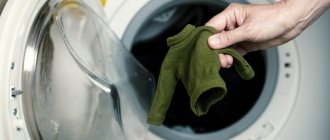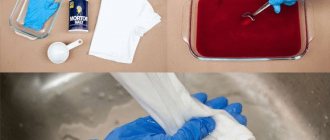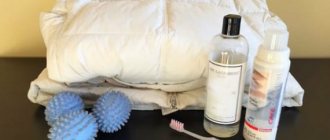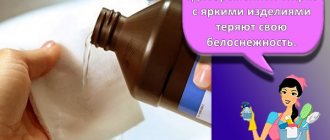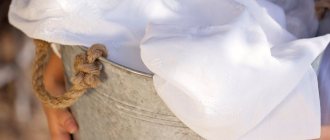How to wash a white T-shirt
If the stains on the T-shirt are fresh, there is a high probability that they can be removed using standard washing in an automatic machine or by hand. However, the housewife often remembers the presence of dirt and yellowness too late, so a regular detergent is not enough.
There are many different effective means to solve this situation.
Most products are made from synthetic fabrics, for which the use of chlorine-containing compounds is contraindicated. The same goes for washing at maximum temperature and evaporation. Useful tips that you can follow to wash a white T-shirt without damaging it:
- wash snow-white items separately from bright and multi-colored ones;
- Delicate fabrics are washed exclusively by hand;
- after washing, the item cannot be dried on a radiator, heated towel rail or heater of any type;
- when soaking, add a small amount of hydrogen peroxide to the water;
- add a few tablespoons of soda to the water for hand washing;
- For automatic bleaching, use industrial oxygen bleach, adding it to the compartment with the powder.
Before bleaching yellowed T-shirts, read the fabric contents on the label.
Precautionary measures
Precautionary measures will help you avoid troubles, fading of light-colored T-shirts, and staining. In order not to spoil the item, you should follow these tips:
- Always sort your clothes by color at home before bleaching/washing. This will help avoid staining.
- You should only use products that will not damage the fabric. Choose options based on the type of material. Follow the instructions carefully.
- You should iron your T-shirt at home after bleaching carefully. High temperature will lead to the formation of yellowness and grayness of the fabric.
- Dry in the shade, avoiding direct sunlight. The sun will lead to fading and the appearance of yellow and gray spots.
- Store white T-shirts, socks, and underwear separately from colored ones to avoid staining.
At home, proper care and care for light-colored wardrobe items will preserve the snow-white shine for a long time. Abuse of frequent washing will lead to loss of attractiveness; the T-shirt will remain lying on the shelf, collecting dust.
The article has been verified by the editors
Whitening methods
If the T-shirt has old or complex stains, it has turned gray or yellowed, or has lost its snow-white color, simple machine or hand washing will not help. It is recommended to pre-soak heavily soiled items. Ordinary boiling will save you from sweat stains and other difficult-to-remove traces.
To return a white T-shirt to its sparkling whiteness, you can use proven methods passed down from generation to generation.
If your washing machine has an intensive wash mode, you can use it. Please note that evaporation and washing at high temperatures are not suitable for delicate fabrics, wool and synthetic fibres.
Soak
Pre-wetting the fabric makes the main wash process easier and reduces the operating time of the washing machine. If the stains are old and difficult to remove, this step cannot be avoided.
You can bleach a white T-shirt by soaking it first.
Basic recommendations for soaking:
- depending on the degree of contamination and the composition used, the item is soaked for 1-6 hours;
- before boiling, the T-shirt can be soaked in soapy water overnight;
- Before you start washing, soaked clothes should be rinsed with clean water.
Folk recipes have been tested for many decades.
Important! Soaking does not always precede other bleaching steps. Sometimes it is enough to keep the item in the prepared solution for several hours, rinse thoroughly under running water and dry on the balcony.
Digestion
A T-shirt can only be boiled if it is made of cotton or linen. Ideal composition for boiling: 200 g of coarsely grated laundry soap and 5 liters of water. For greater efficiency, you can add 2 tbsp to the boiling mixture. hydrogen peroxide or ammonia.
Boiling is an old proven method for white things.
The digestion time depends on the density of the tissue. If the material is thin, it is enough to bring the mass to a boil. Durable products are boiled over low heat for about 20-30 minutes after boiling.
After completing all manipulations, you need to wait for the solution to cool. The product should be rinsed thoroughly under running water.
Intensive wash
If you don’t have the time and energy to boil or soak, you can choose a special washing machine mode. It is recommended to bleach only cotton and linen using the intensive washing method.
Dry white items made from natural fabrics in the sun, this will help consolidate the bleaching effect.
You need to pour or pour detergent into the removable compartment for washing powder, and then add professional bleach (for example, white, Vanish) to it. The T-shirt must be washed at a temperature of at least 70 degrees, at maximum speed and with a spin cycle.
Synthetic T-shirts and tank tops cannot be treated with chlorine-containing compounds.
For many housewives, this method seems uneconomical. Firstly, the wash cycle takes much longer. Secondly, a larger amount of powder is required than usual.
Important! Washing gels are combined only with liquid bleaching compounds; only bleaching powders should be added to powdered detergents.
Useful tips
Now you know how to return the whiteness to a T-shirt. Below are some simple but important tips on how to avoid further yellowing of such things.
- Choose your temperature carefully. This applies to both washing and ironing. Excessively hot water (especially in combination with bleaches or powders that are not suitable for this type of fabric) or an overheated iron can generously endow a white item with yellowness. By the way, the iron can leave stains even if there was stagnant water in it during ironing.
- Products made from natural fabrics can be dried in the open sun. But this procedure is contraindicated for synthetic materials: they may turn yellow or gray.
- Dry things thoroughly before putting them in the closet, and monitor the air humidity in the room where they are stored: high moisture content contributes to the appearance of mold stains, which are almost impossible to remove.
- Take steps to reduce sweating. First of all, maintain good hygiene and remove hair from your armpits. In hot weather, try not to eat excessively hot and spicy foods.
- Do not use deodorants containing aluminum - when in contact with sweat, they form those stubborn yellow stains on things.
- Be careful when choosing bleach. It is important that it is suitable for a specific type of fabric, otherwise yellowing cannot be avoided.
- Use water softeners (you can use lemon juice or vinegar instead of industrial ones). Salts contained in hard water, reacting with washing powder, can give the product a yellowish color.
Follow these rules, and your things will remain snow-white for a long time and will be pleasing to the eye. You will have to bleach them less often. This means that the fabric will retain its properties longer.
Folk remedies
Modern industrial compositions work wonders and easily help wash yellowed and gray T-shirts with traces of sweat and other contaminants. However, until recently, the range of household chemical stores was not so wide, and housewives had to use traditional methods.
Folk remedies for white clothes will help you deal with stains.
The use of peroxide, soda, laundry soap, mustard and other means allows you to return the product to its original appearance without significant material costs and large labor costs. Some methods have shown effectiveness in combating old stains that cannot be washed off with household chemicals.
Laundry soap
This product allows you to whiten and clean even delicate fabrics from traces of sweat or old stains. A yellowed, dirty, greasy T-shirt should be slightly moistened and well soaped with laundry soap, and then placed in a plastic bag.
The soap bar has a pungent, unpleasant odor; when preparing, open the windows for ventilation.
It is necessary to wrap it tightly to prevent air from entering. The product is left in this form for a day, after which it is rinsed with tap water. If desired, you can wash your clothes.
Important! Laundry soap does not leave any odor on wardrobe items. Even if wet things give off a slight soapy aroma, after drying completely in the fresh air, not a trace will remain of it.
Hydrogen peroxide
To remove small yellow stains, simply pour a little peroxide onto the stains and leave for half an hour until absorbed. Then the item should be rinsed under running water.
The T-shirt is rinsed in clean water and dried.
Synthetic and cotton fabrics with stubborn stains, grayed or yellowed are cleaned using a mixture of hydrogen peroxide and ammonia in a 2:1 ratio. It is necessary to prepare 30 ml of a solution from substances in the specified ratio and mix with 2 liters of water. The contaminated T-shirt is placed in the liquid for several hours.
To achieve maximum effect, it is necessary to periodically stir the clothes. After soaking, the item is rinsed thoroughly.
White
A concentrated substance can be used for bleaching only if the item is made of dense, durable fabric. It is better to wash tablecloths, towels, and bed linen with white, rather than T-shirts, which are most often contraindicated to be exposed to aggressive compounds.
Whiteness perfectly whitens things.
How to properly wash a white T-shirt using this bleach:
- wear gloves to protect your skin;
- Fill a basin with 3.5 liters of cool water, add 1 tbsp. whiteness and stir;
- Pre-soak the T-shirt in soapy water, add the resulting solution;
- leave the item in the liquid for 15 minutes (if the fabric is very thick - 20);
- Rinse the T-shirt thoroughly.
Important! If you do not rinse the whites well enough, continued wearing of such clothing may lead to an allergic reaction. After washing, it is advisable to dry the T-shirt on the balcony or other place with constant circulation of fresh air.
Boric acid
Before using this method, you need to wash the T-shirt. 1-2 tbsp. the substances are dissolved in 3 liters of warm water, then the product is rinsed in the resulting solution for several minutes. The soaked clothes should be thoroughly rinsed under running water, and they will become snow-white again.
Soda
Baking soda is one of the most affordable means for bleaching and restoring snow-white clothes.
Baking soda is a good stain remover for a white T-shirt.
This versatile substance can be used in several ways:
- In the washing machine. Pour a standard amount of detergent into the powder compartment and add ½ cup of baking soda. You need to select a mode suitable for the material from which the T-shirt is made and wash it in the machine.
- Handwash. It is worth preparing a solution of 5 liters of warm water, 5 tbsp. hydrogen peroxide and 2 tbsp. soda The T-shirt is soaked in the resulting liquid for 3-4 hours. In the absence of peroxide, it is enough to mix only water and 10 tbsp. soda, and then soak the item in the same way.
- Boiling. Add 3 tbsp to a pan of water. soda You need to boil a dirty T-shirt in a solution and it will become snow-white again.
Baking soda will help remove stains on clothes.
Laundry soap and manganese
If clothes have acquired a grayish tint and are no longer pleasing with their crystal whiteness, you can use a method that has been used by experienced housewives for decades.
If you can’t find soap of the required concentration, then use Antipyatin soap.
Procedure:
- grate a piece of laundry soap on a coarse grater;
- pour the resulting shavings into a basin with 2 liters of warm water;
- add potassium permanganate until a light pink solution is obtained;
- dip the T-shirt completely into the liquid, cover the basin with a towel or film, and leave overnight;
- wash clothes in any way - in a machine or by hand.
Potassium permanganate will return the white color to things.
Using this method you can bleach old yellowish items. Soap and manganese are effective in combating old stains.
Mustard
The product helps to cope with the yellowness or grayness of white clothes. It is necessary to dissolve mustard powder (5 tbsp) in hot water (5 l), strain the liquid and dip a T-shirt in it, leave for several hours. After the specified time, the product is thoroughly rinsed with water and dried naturally.
Mustard will help achieve white color.
If your shirt has stains, you can use mustard in a different way. Mustard powder is mixed with water to form a paste. The mixture is applied locally to the dirt, then the item must be placed in a plastic bag and left overnight. In the morning you should wash the product by hand or in a washing machine.
Acetylsalicylic acid
If you don't have industrial bleach on hand, aspirin will come to the rescue. It is necessary to dissolve 5 tablets in 7 liters of clean water. The T-shirt should be immersed in the resulting liquid for 8-10 hours (or overnight).
Aspirin is an option for whitening things.
After removing the item from the solution, you need to wash it in any way (automatically or manually).
Important! Experts recommend additionally adding a few tablets of acetylsalicylic acid directly to the drum of the washing machine.
Lemon acid
This method is not suitable for bleaching delicate fabrics and wool. To lighten a white T-shirt, you need to:
- dissolve citric acid granules in boiling water (1 tablespoon of substance per 1 liter of water);
- soak the product in the solution for 5-6 hours;
- rinse under running water.
Important! Citric acid (1 tbsp) can be replaced with freshly squeezed juice of two lemons.
Citric acid is an assistant in whitening things.
Some housewives pour several bags of citric acid into the drum of the washing machine before washing. Detergent is added as usual to the special powder compartment. Then you should start the wash at maximum temperature. Things become snow-white again, this way you can remove the gray tint and yellowness.
We use hydrogen peroxide and ammonia
To remove yellowness from white fabrics, another available product is often used - hydrogen peroxide. The popularity of this product is high not only due to its effectiveness, but also due to its careful treatment of fabric. With the help of hydrogen peroxide, even delicate fabrics, such as silk, can be restored to their former whiteness. In addition, this remedy is popular among young mothers, since solutions prepared on the basis of this substance usually do not cause allergies.
So, what do you need to remove yellow stains from fabric with hydrogen peroxide?
- 5 liters of hot water (for cotton fabrics the water temperature should be 70 degrees, for delicate ones – 30 degrees is enough);
- 25 ml of hydrogen peroxide (about 3 tablespoons);
- 25 ml of ammonia.
Place items that need to be white again in the resulting solution and leave for 30–60 minutes. Then rinse the laundry first in warm and then in cold water.
If you use this method to bleach delicate fabrics and the water temperature does not exceed 30 degrees, then you can add a couple of tablespoons of washing powder to the solution and increase the exposure time to 2-3 hours.
When using this method, follow several important rules.
- Firstly, make sure that the items are completely in the solution, otherwise there may be stains where things floated to the surface.
- Secondly, the laundry needs to be stirred several times to avoid uneven bleaching.
Professional products
Household chemicals stores offer many industrial compounds that show high effectiveness in whitening wardrobe items.
Use professional whitening products.
There are several types of professional products, the choice of which depends on the composition of the fabric, the degree of contamination and other factors:
- Oxygen bleaches. They are suitable for any type of fabric and can handle a variety of stains. Cons: short shelf life, high price.
- Contains chlorine. Chlorine bleaches are the most effective and affordable. However, they cannot be used for washing synthetic, wool T-shirts and delicate fabrics. Chlorine-containing products should not be added to the washing machine; moreover, they often cause allergic reactions.
- Optical. Such compositions do not cope with dirt, but create the illusion of a white T-shirt. The spots are masked using special reflective particles.
We use table salt
Table salt is an excellent bleaching agent.
Good results can be achieved using regular table salt. To prepare the solution you need:
- 10 liters of hot water;
- 2 cups salt;
- 70 ml of ammonia;
- 400 ml hydrogen peroxide.
It is necessary to keep things in such a solution until the desired result is obtained. As soon as you see the result, rinse and dry the products.
How to bleach a graphic T-shirt
If the image is printed using thermal printing, white clothes can be bleached using any method. It is not so easy to lighten a product with a print. Under no circumstances should bleach or other aggressive substances be used.
White items, especially the popular T-shirts, wear out very quickly.
Otherwise, the design may fade or leave stains on the snow-white surface. It is better to use professional oxygen or optical brighteners; such compositions will carefully bleach the fabric and will not affect the image.
Important! Before you bleach a printed T-shirt, you need to take care of its safety. The pattern will be fixed and will not unravel in the future if, before the very first wash, you keep the product for several hours in warm water with added salt.
Boiling
You can bleach a white T-shirt by boiling, but this method is the most radical and is not used for synthetic materials. There should be no drawings, prints, or lace on clothes.
First, pour water, immerse the T-shirt and put it on fire. After the water boils, turn on the fire. As a bleach, you can use a chlorine-containing product, laundry soap or powder. The water is stirred so that the T-shirt does not burn and cleans evenly. Wooden tongs are used for mixing.
Boiling time – no more than 2 hours. As practice shows, 30 minutes is enough, after which the thing becomes snow-white and the water dark. After boiling is complete, wait for the water to cool, drain it, and rinse the item well.
You can use baking soda for boiling. Add 3 tablespoons, boil using the standard method.
Author:
Zakharova Nina Afanasyevna
I hope you like my article! If you find any shortcomings, just write to me about it! I am always ready for a conversation and will answer any questions you have, ask them!

